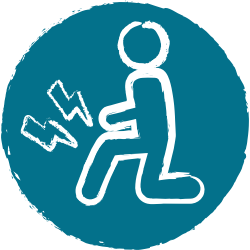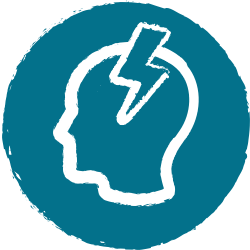Content provided by:

Relaxation
The Relaxation Response
When humans face a threat, our bodies respond through the fight or flight response. The body gets ready for action – literally, either ready to fight or ready to run to safety – by bringing extra blood flow to the muscles, raising heart rate and blood pressure, and increasing muscle tension for speed and strength. Like the body’s response to pain, the ‘fight-or-flight’ response was intended for rare moments of extreme need to help you survive danger. The body was not meant to be this way all of the time. Most importantly, while these changes are helpful for our survival from a life or death threat, they have consequences to our physical and emotional well-being if they persist for a long period of time. This includes making our pain, stress and fatigue worse.
One tool that can be effective in managing pain, fatigue, and other symptoms is to learn how to stop or calm the fight or flight response. Ongoing MS symptoms do not need to be met by this alarm-type response. If we can calm ourselves, we can also calm our nervous system, reduce our stress, and give ourselves a chance to find other ways to cope with our pain, fatigue, and other symptoms.
We calm our system through relaxation strategies. A state of relaxation is the opposite of the ‘fight-or-flight’ response and changes how you deal, emotionally and physically, with stress. Relaxation is a very effective tool for managing several common MS symptoms, including pain, stress, emotional changes, problems with sleep and fatigue.

For example, relaxation is helpful for pain because:
- Tense muscles make pain worse. Your body naturally protects itself by tensing muscles around an area that hurts or that it needs to protect. When your muscles are tense for too long, your pain may increase. Relaxation helps decrease this muscle tension that occurs when feeling pain.
- Relaxation is also a way to counter the well-known negative effects stress has on pain and other physical problems (counteracts the ‘fight-or-flight’ response).
- Relaxation also has a beneficial effect on the areas of the brain that are involved in sensing and reducing pain.

Relaxation can also be helpful for other symptoms because:
- It is common to feel tense when you feel depressed or anxious. Relaxation helps decrease physical and mental tension that can make emotional changes and anxiety worse.
- Relaxation can help you sleep better.
- Relaxation is a good way to take a break or ‘time-out’ from stressful situations or emotions. It is a helpful activity you can do to take care of yourself.
- People are usually better at planning and problem solving when they feel relaxed compared with when their emotions are heightened and they feel stressed.

“I try to relax, but it doesn’t seem to help”
Do you still feel tense even after trying to relax? Restful activities such as just lying down or watching TV may not trigger the relaxation response. The relaxation response occurs when you teach your body how to relax more fully and on command by using active relaxation techniques, such as deep breathing. As you practice these techniques, they will become more natural and help you reach a calming state of relaxation. Use the Relaxation Work Sheet to help you in this process.

With regular practice, relaxation skills may help you:
- Lessen your symptoms, such as pain or stress.
- Raise your energy level.
- Sleep better.
- Ease your stress.
- Manage your emotional responses, such as anger or anxiety.

In this module you will learn how to:
- Achieve the relaxation response.
- Overcome barriers and challenges to practicing relaxation exercises.
- Utilise relaxation exercises in your daily life and MS symptom management.

Relaxation: Achieving the Relaxation Response
A good relaxation exercise is one that you enjoy and will do regularly.
My MS Toolkit offers you several different relaxation exercises to try:
- Deep breathing.
- Autogenic relaxation.
- Guided imagery.
- Progressive muscle relaxation.
- Mindfulness meditation.
You can learn and practice any or all of these relaxation exercises so that by the end of the program, you will have found one or two that you can use regularly in the future to help manage your MS symptoms.
Autogenic relaxation
Body scan 1
Body scan 2
Deep Breathing Exercise (4-5 minutes):
- Also sometimes called ‘belly breathing’ or ‘controlled breathing’.
- Focuses on your breathing to help you relax.
- One of the easiest and most effective relaxation skills.
- Allows us to breath more deeply.
Guided imagery
Progressive muscle relaxation
Mindfulness meditation
Choose your next
My MS Toolkit module


This is not a replacement for advice from your healthcare professional or healthcare team. Please consult your healthcare team first and foremost about your multiple sclerosis and the self-management advice contained within this website.
Developed by the University of Michigan, provided by Janssen.
References
[1] Ehde DM, et al. Chronic pain in a large community sample of persons with multiple sclerosis. Mult Scler. 2003;9(6):605-611.
[2] Ehde DM, et al. The scope and nature of pain in persons with multiple sclerosis. Mult Scler. 2006;12(5):629-638.
[3] Ehde DM, et al. Chronic pain in persons with multiple sclerosis. Phys Med Rehabil Clin N Am. 2005;16(2):503-512.
[4] Svendson, et al. Pain in patients with multiple sclerosis: A population-based study. Arch Neurol. 2003, 60(8): 1089-94.
